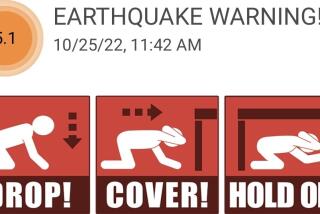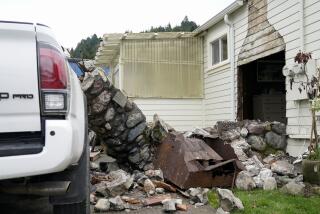Using the Internet to Unearth Violators of Test Ban Treaty
Now that 140 nations around the world have signed on to the Comprehensive Test Ban Treaty, the really tough part begins.
How do you find out whether someone is cheating?
Scientists at Cornell University think they are providing at least part of the answer. They are building an Internet site that will help scientists sort through earth-shaking events for signs of illegal nuclear testing.
The Geographic Information System (https://atlas.geo.cornell.edu) will rely on 300 sensors scattered around the world to help distinguish nuclear explosions from earthquakes, mining detonations, demolition projects and other events that cause shock waves to ripple through the ground.
The system, sponsored by the U.S. Defense and Energy departments, will provide instant maps that show the geological history of any region, including such things as seismic activity and mining. Shock waves that are inconsistent with the history of an area might be grounds for suspicion of a nuclear test.
“The treaty calls for on-site inspection if a country suspects that another country is cheating,” says Cornell’s Muawia Barazangi, senior scientist on the project.
Verification will require speedy access, so United Nations inspectors will need to build their case rapidly. And accurately.
“You want to make sure you are not fooling yourself” before demanding an inspection, Barazangi says. “No country wants to be inspected, so the more information you have to bear on the problem, the better the situation.”
The new system is one of several tools that will be used by nuclear sleuths. Others include satellite images, intelligence reports and ground-based photographs.
Barazangi’s hope is that his project will reduce the time it takes to build a strong enough case to warrant an on-site inspection. Investigators need to get to the scene within days--not weeks--before critical evidence disappears.
Stanford University physicist Sidney D. Drell, long involved in the nuclear test-ban effort, says the system should ease the difficult ratification process that lies ahead. One question that, Drell says, the various governmental bodies (including the U.S. Senate) must answer is: Can compliance with the treaty be verified?
“That’s exactly what this is for,” Drell says. “You’ve got the database right there that tells you where mining is going on, where there are active seismic regions, and where the quiet regions are.
“If you saw something [in a quiet region], you’d be suspicious,” he adds.
Satellite photos and intelligence data could be added to the map, helping authorities decide whether the case is strong enough to call for an inspection.
Verification is more of a problem for smaller tactical weapons than for large warheads. A large nuclear explosion carries a different seismic signature than an earthquake, for example. Earthquakes are caused when two chunks of the Earth’s crust slip past each other. In an explosion, energy radiates out in all directions, giving the initial energy pulse a different shape than an earthquake.
Sensors used by the Geographic Information System will detect blasts as small as one kiloton anywhere in the world, and scientists will be able to tell instantly whether it is inconsistent with the geological history of the region. But Barazangi admits that it might be possible to circumvent the system by simply setting off the explosion in a region that is seismically active.
That is why authorities need many tools, he says.
The system fills in some blanks in the geological record. The seismic nature of some areas in the Middle East and North Africa, for example, was not well documented until researchers at Cornell began collecting information in 1990, Barazangi says. Those data have been folded into the Geographic Information System.
Although designed specifically for the Comprehensive Test Ban Treaty, which President Clinton signed in September, Barazangi says the system is also a valuable educational tool.
It is available to anyone with Internet access. It is not as user-friendly as most sites, and a knowledge of geological terms is helpful, but anyone can check out his or her own neighborhood by typing in longitudes and latitudes that define the area.
Users can create their own maps showing mining activity, earthquakes and even rivers and highways and towns.
Teachers rank among the site’s most frequent users, which pleases Barazangi, but he hopes that its primary role will be to reduce nuclear proliferation.
*
Lee Dye can be reached via e-mail at [email protected]
More to Read
Sign up for Essential California
The most important California stories and recommendations in your inbox every morning.
You may occasionally receive promotional content from the Los Angeles Times.










